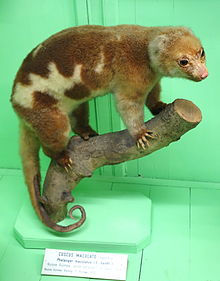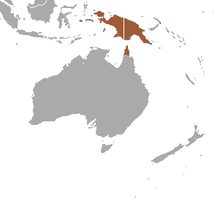Spotted cuscus
| Common spotted cuscus | |
|---|---|
 |
|
| Spilocuscus maculatus (male) | |
| Scientific classification | |
| Kingdom: | Animalia |
| Phylum: | Chordata |
| Class: | Mammalia |
| Subclass: | Marsupialia |
| Order: | Diprotodontia |
| Family: | Phalangeridae |
| Genus: | Spilocuscus |
| Species: | S. maculatus |
| Binomial name | |
|
Spilocuscus maculatus (E. Geoffroy, 1803) |
|
 |
|
| Common spotted cuscus range (brown — native, red — introduced, dark gray — origin uncertain) |
|
The common spotted cuscus (Spilocuscus maculatus) is a cuscus, a marsupial that lives in the Cape York region of Australia, New Guinea, and nearby smaller islands.
The common spotted cuscus is about the size of a common house cat, weighing 1.5 to 6 kilograms (3.3 to 13.2 lb), body size about 35 to 65 centimetres (14 to 26 in) long, and a tail 32 to 60 centimetres (13 to 24 in) long. It has a round head, small hidden ears, thick fur, and a prehensile tail to aid in climbing. Its eyes range in colour from yellows and oranges to reds, and are slit much like a snake's. All four of its limbs have five digits and strong, curved claws, except the first digit on each foot. The second and third digits of the hind foot are partly syndactylous: they are united by skin at the top joint, but divide at the claws. These smaller claws can serve as hair combs when cleaning. The first and second digits of the fore foot are opposable to the other three, helping it grip branches while climbing. The undersides of its paws are bare and striated, which also help it grasp trees and food. The first digit on the hind foot is clawless and opposable.
It has thick, woolly fur of varying colours depending on age, sex, and location. Males are typically grey/white or brown/white with splotchy patterns on their back and a white underbelly. Only males have spots. Females are usually white or grey and unspotted. Some completely white individuals are known in both males and females. As the young grow, they go through a series of color changes before reaching sexual maturity around one year old. Colouration varies from reds and whites to buffs, browns, light greys, and blacks. Unlike some other species of cuscuses or possums, the common spotted cuscus does not have a dorsal stripe on its fur.
The curled, prehensile tail is a distinctive characteristic of the common spotted cuscus. The upper part of the tail closest to the body is covered in fur, while the lower half is covered in rough scales on the inside surface to grip branches.
The common spotted cuscus is typically very shy, so it is rarely seen, especially in northern Australia. It is nocturnal, hunting and feeding at night and sleeping during the day on self-made platforms in tree branches. It also has been found resting in tree hollows, under tree roots, or among rocks. It is slow-moving and somewhat sluggish, sometimes mistaken for sloths, other possums, or even monkeys. Unlike its close relatives, the common spotted cuscus has been observed feeding during the day on rare occasions.
...
Wikipedia

